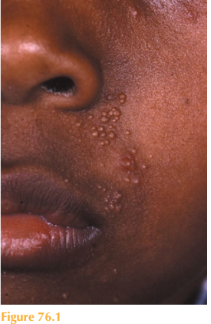History
A 38-year-old woman is admitted to hospital with a 6-week history of increasing shortness of breath on exertion, fever, dry cough, malaise and weight loss. She also complains of multiple ‘spots’ on her face and chest, which have become more numer-ous over the past 2 weeks. Her past medical history is unremarkable and she has no history of previous skin problems. She has been taking paracetamol for her fevers, but otherwise is not on any regular medication.
Examination
She looks unwell and is breathless at rest, her temperature is 38.5 ̊C; chest examination reveals mild crackles in the mid zones only. On her nskin she has multiple, small (2-3 mm in diam-eter), firm, flesh-coloured papules on her face (Fig. 76.1) and chest. Many of the papules have a central umbilicated depression, the surrounding skin is normal.


Questions
• What is the skin diagnosis?
• What is the respiratory diagnosis?
• What is the unifying underlying diagnosis?
When patients present with a cutaneous eruption in association with other signs or symptoms, the skin can often give a vital clue to the underlying/unifying diagnosis. Skin can be the ‘window’ to internal disease. This patient had very characteristic skin lesions of molluscum contagiosum. The flesh-coloured umbilicated papules are caused by a cutaneous infection with a highly contagious poxvirus. Gently squeezing an individual lesion characteristically causes the extrusion of semi-solid white material (comprising the molluscum bodies). Poxvirus is spread by direct contact and autoinoculation is common. When adults present with multiple lesions, then underlying immune compromise should be suspected. Molluscum contagiosum in young children is seen in otherwise healthy individuals. This patient was found to be HIV-positive with a viral load of 632 000 copies/mL and a CD4 lymphocyte count of 3. It is estimated that approximately 10 per cent of adult HIV patients have molluscum contagiosum and that the more widespread the lesions, the lower their CD4 lymphocyte count.
The patient’s progressive respiratory symptoms were caused by co-infection with Pneumocystis (carinii) jiroveci and Mycobacterium tuberculosis pneumonia. This dual respiratory infection is not uncommon in patients from sub-Saharan Africa.
The patient immediately received treatment for her acute pneumonia and tuberculosis and within a few weeks started on HAART (highly active antiretroviral therapy). After discharge from hospital she was seen in the dermatology out-patient clinic and had the molluscum lesions treated fortnightly with cryotherapy (liquid nitrogen). The molluscum slowly cleared with a combination of cryotherapy and immune reconstitution.
Molluscum contagiosum is usually self-resolving in children and those with an intact immune system. Inflammation around the lesions is usually seen just prior to their resolu-tion indicating activation of the patient’s own immune system in dealing with the cutane-ous infection. Most attempts at treating molluscum lesions revolve around destructive/ irritant methods, such as with acid chemicals, cryotherapy and immunotherapy (topical imiquimod 5% cream daily).
KEY POINTS
• Multiple molluscum contagiosum lesions in an adult may indicate underlying immuno-deficiency.
• Molluscum contagiosum is a poxvirus spread by direct contact and is not uncommon in children.
• Molluscum is self-resolving, but locally destructive treatments may speed resolution.
need an explanation for this answer? contact us directly to get an explanation for this answer